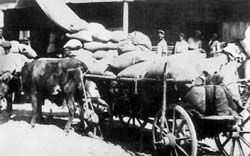Ukrainian Golgotha in Documents

The business of politicians is to provide conditions for the free and harmonious development of a society. Writers are to unveil the lasting mysteries of human spirit. Historians must decipher mysteries and fill in the gaps in the past, analyzing the reasons for the people’s unforgettable victories and hair-raising national catastrophes, using authentic facts, seeing that the gains of such victories are not lost and catastrophes never repeated.
The Manmade Famine in Ukraine (1932-33) was the tragedy of the century. Things like that cannot and shall not be forgiven; letting them sink into oblivion is another grave crime. Emotions, however, are not what we need at this stage. We need an analysis allowing to understand how it became possible at all. An important landmark on this road was the appearance of the book Commanders of the Great Famine in late 2001 (edited by Yuri Shapoval, Ph.D. in history, and Valery Vasyliev, Candidate of Science {history}, in collaboration with Larysa Malashenko, Moscow historian and archivist, and Prof. Stephen Wheatcroft of the Australian National University — a graphic example of international cooperation).
The new publication is unusual in many respects. It is no secret that many historians, driven mainly by political convenience, come up with tomes of documents lacking comment and scholarly treatment. Shapoval and Vasyliev deserve every praise for showing a polarized approach. The documents in their book (40% of the body of the text) are preceded by a fundamental work, a chapter titled “1931-33 Famine: a Look from the 21st Century,” offering a detailed analysis of general aspects of the USSR and Ukrainian Soviet leadership’s policy at that period (Valery Vasyliev), “The Third CP(b)U Conference as a Prologue to the Tragic Famine” (Yuri Shapoval), “Modern Concept of the Nature and Death Toll of the 1932-33 Famine in Ukraine” (Stephen Wheatcroft), “Documents concerning the Holodomor from Molotov’s and Kaganovich’s Private Files” (Larysa Malashenko).
Of course, all this by no means eclipses the importance, novelty, and thrilling effect of numerous documents in the second part, published for the first time or little-known in Ukraine. Just two examples may illustrate the misanthropic essence of the Stalin regime. As the famine was gaining scope and momentum, the Central Committee of the all-Union Communist Party and the Council of People’s Commissars of the USSR sent a telegram to the Ukrainian leadership (June 21, 1932), admonishing that “no deviations from ... set grain procurements plan by collective farms and individual farmsteads will be tolerated, under any circumstances, in terms of scope and delivery deadlines.” From a telegram sent to Stalin by Molotov (October 1932) “It is necessary to quickly overcome sentiments of demobilization ... in party organizations facing the most important grain procurements task in November.” Peasants were robbed of the last grain and parents ate their children.
The inhuman Bolshevik internationalists thought they would be able to conceal their dark deeds from the judgment of history, but nothing is secret that shall not be made manifest, a formidable truth for all torturers of all times. The commanders of the great famine are to face the tribunal of nations and this is precisely what lends Shapoval and Vasyliev’s book such tremendous moral value, the more so that it came off the presses in the year marking the Holodomor’s seventieth anniversary.






